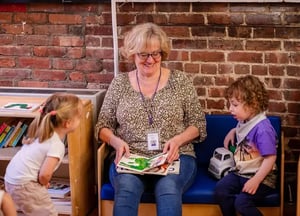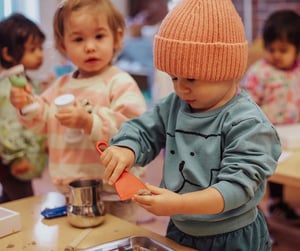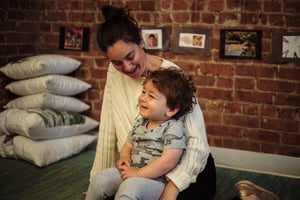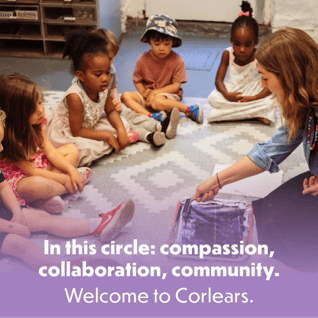
Toddler Classrooms:
12–24 Months
Program Overview › Toddlers
About
Corlears School provides toddlers ages 12–24 months with a nurturing start to their school journey. Grounded in responsive caregiving and the principles of child development, toddler classrooms are designed to support children in developing independence, autonomy, joy, and wonder through developmentally appropriate learning experiences.
Children must be 12 months old on or before September 1 to be eligible for a fall start. For children turning 2 on or before October 1, check out our Nursery classrooms.
Toddler classrooms follow a half-day school schedule from 8:30 to 11:30 a.m.; families can choose to enroll for 3 or 5 days, with classes meeting on Monday/Wednesday/Friday or Monday through Friday.
Extended days are also available as an optional add-on from 11:30 a.m to 3 p.m. or 6 p.m.
While a full-year tuition commitment is required for the half-day school program, extended days are available for registration on a month-by-month basis at a competitive rate.
Individualized responsiveness is at the heart of the work we engage in with children and families. No matter the program you choose, our educators are trained to provide exceptionally nurturing comfort and care as a meaningful part of the separation-attachment process. This ensures every child feels a sense of uniqueness, community, and belonging.
There's no simpler way to start your child's Corlears journey than registering for the Toddlers! Applications are accepted year-round and processed on a rolling basis.
To apply, submit an application on our website; following submission, you will be prompted to pay a $50 application fee. Once you have applied, a member of our admissions team will reach out to discuss next steps, including a private tour.
Toddlers recommended for reenrollment in our Nursery School are not required to go through a more lengthy admissions process and will instead follow a simplified reenrollment process.
Each classroom is capped at 10 students, led by a Head Teacher and supported by 1-2 Associate Teachers or Classroom Teaching Assistants.
At Corlears School, all Head Teachers hold Master's degrees in early childhood or elementary education, in addition to role-specific certifications. Head Teachers are supported by Associate Teachers and Classroom Teaching Assistants who may hold a variety of early childhood-related degrees in addition to years of experience working with very young children.
Related Links
Why Choose Toddlers?
Caregiving as Curriculum
The cornerstone of the toddler classroom is an approach we refer to as "caregiving as the curriculum." Every aspect of your child's experience is thoughtfully designed to foster:
- Secure attachments: Gradual separation from a caregiver to establish trusting relationships with teachers and peers.
- Social and emotional growth: A gentle process that nurtures independence while creating a strong sense of community.
- Play and discovery: Exploration in spaces intentionally created to spark curiosity and hands-on learning.

Play-Based Development
At Corlears School, we believe that children learn best through a play-based approach that emphasizes hands-on exploration and discovery.
In the toddler classroom, all activities are designed to support growth in key developmental areas, including:
- Physical development: Climbing play structures in the yard, running outdoors, jumping, hopping, riding a bike, throwing a ball, dancing, playing in the gym.
- Language, literacy, and linguistics: Singing songs, storytelling, rhyming, being read to, writing, drawing.
- Mathematical and scientific thinking: Playing with manipulatives like puzzles and building blocks, counting objects, measuring, and comparing sizes, shapes, heights, and lengths.
- Social and emotional learning: Responding to and interacting with peers, teachers, and caregivers while reenacting lived experiences and engaging in imaginative, dramatic play areas.
- Sensory integration: Playing with textured objects like sand, water, paint, clay, fabric, and soft climbing structures.
These learning experiences take place in expansive, light-filled classroom spaces that are intentionally designed to foster engagement and intimacy between children and their teachers. Throughout the school year, spaces evolve to meet our students' emerging interests and curiosities.

Responsive Daily Schedule
The below sample schedule will give you an idea of what your child can expect in the toddler classroom. The individualized, reflective-responsive approach is designed to prioritize our students' emerging needs and interests, so the exact day-to-day might change over time.
Visit our blog to learn more about how the rigor of school programs differ from traditional daycare settings.
Arrival time is an immediate opportunity for our youngest students to feel a sense of belonging and inclusion as they enter the classroom with their grown-up. For example, even beloved stuffed animals — which we refer to as "transitional objects" — are affirmed and acknowledged by their teachers, which helps the children feel known and seen.
School-to-Home Partnership
We recognize that parents and caregivers are an integral part of a child's first school experience. Our teachers work to build strong connections between school and home through open communication, collaboration, and a deep understanding of every family’s unique needs.
Families are invited to share their own reflections on their child’s milestones, ensuring alignment between classroom observations and home experiences. This collaborative approach supports a shared understanding of each child’s individual growth, reinforcing our commitment to inclusive measurement and evaluation.
Together, we cultivate a partnership that nurtures your child’s growth and confidence with the goal of laying the foundation for a lifelong love of learning.

Go Inside the Early Childhood Curriculum
In these videos, Early Childhood Division Developmental Specialist Colleen Goddard, Ph.D., answers frequently asked questions about the early childhood curriculum at Corlears School, how children learn through play, and much more.



Connect with Admissions
Interested in enrolling your child at Corlears School? Submit an inquiry and a member of the admissions team will follow up as soon as possible. For any questions, email us at admissions@corlearsschool.org. We look forward to getting to know your family!

